|
  | Evelyn Glennie (1965 -- ) Percussionist, recording artist, composer The first percussionist to create and sustain a solo career "Music, for me, is a language, something I can communicate with." Evelyn Glennie | 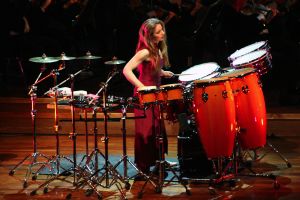  |
Hear Evelyn play Ney Rosauro's Concerto for Marimba! |
1965 – 1985 Hushed sounds and a passion for percussion | 1965 prices and events |
The daughter of Herbert Glennie, a beef farmer, and Isobel Glennie, a school teacher, Evelyn grew up with her parents and two brothers on a farm near Aberdeen, Scotland. Her mother played the organ and her father played accordion with a Scottish country dance band.
A musically gifted child and a promising student of piano and clarinet, Evelyn had perfect pitch—the ability to identify or sing a note by ear. At the age of eight, she began to complain of sore ears and hearing loss. Three years later, she began using a hearing aid, but found this distracting and discarded it. [1] By age twelve she was profoundly deaf, having the ability to hear some sounds but of extremely poor quality. “I was beginning to become an angry person,” she says. [3]
Then, a revelation. After seeing some classmates play percussion at a concert, she realized she might be able to express emotion with percussion instruments. “Everyone thinks that percussion is all about rhythm,” she says, “but every instrument is about rhythm. I was interested more in the color and emotion." [4] She began lessons with a percussionist. He had her put her hands on the copper ball of the tympani to feel the vibrations. When he tuned two drums to different pitches, one high, one low, she learned to discriminate between higher and lower pitches. “Higher sounds are in the higher parts of your body,” she says. “Low sounds are in the lower parts of your body.” [3] Eventually, she learned to distinguish smaller and smaller intervals. She now perceives the vibrations she feels in her hands, wrists, lower body, and feet. [1]
After mastering various percussion instruments, she applied to the prestigious Royal Academy of Music in London in 1982. She met with considerable skepticism. “There’s no solo literature for percussion,” they said, “and no one’s done it before.” [2] They didn’t reckon on her determination. Referring to what she calls her Scottish stubbornness, she says, “You have to create your own opportunities.” [2] Others might call it refusal to take no for an answer or a single-minded sense of purpose. | Bread: .21/loaf Milk: 1.05/gal Car: $2,350 Gas: $ 0.31/gal Ave House price: $21,500 Ave.Income: $7,704/year Minimum wage: $1.25/hour President: Lyndon B. Johnson The Vietnam War and Civil Rights movement dominate the news. US begins bombing raids on North Vietnam. In unpopular move, Australia Prime Minister sends 800-man battalion to Vietnam to fight Vietcong. Teach-ins at universities in US and Britain protest events in Vietnam, Southern Rhodesia, and violations of civil rights. President Johnson orders federal forces to protect civil rights march in Alabama led by Martin Luther King, Jr. Race riots last five days in Watts area of Los Angeles. US Stock Exchange admits first female members. Top Books: In Cold Blood, Truman Capote; Why We Can't Wait, Martin Luther King, Jr. First performance of Leonard Bernstein's Chichester Psalms Beatles awarded MBE in Queen's Birthday honors. Some previous recipients return their honors in protest. |
The RAM did accept her, but she had to overcome new obstacles. In order to practice she had to rent a music studio, transport her instruments there, do a three hour practice session and return her instruments to her storage locker. This often took an entire day. She began practicing silently, studying the music to memorize and internalize it, a habit she continues to this day. [2] At right: Evelyn, barefoot, playing woodblocks | 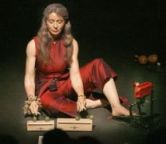  |
In 1982, she wrote to famed Japanese composer and marimba player, Keiko Abe, and asked to study with her. Upon learning that Abe would soon visit Germany, Evelyn traveled there from London and slept in the bus station because she had no money. Impressed by her determination, Abe accepted her as a student and became an important influence in her musical development. At right, Keiko Abe plays marimba Evelyn calls Abe’s music “a map or a version on which one can improvise” that allows her to create a new piece of music each time she plays it. [2] |   |
1985 – 2000 Blazing new trails |
In 1985, Evelyn graduated with honors from the Royal Academy of Music, having won RAM’s highest award, the Queen’s Commendation Prize. Aware that her limited hearing might rule out playing in an orchestra, she set her sights on a new goal. She would become a percussion soloist. Because the Royal Academy of Music had only a 4-octave marimba and did not teach the 4-mallet technique, she traveled to Japan to study the five-octave marimba with Keiko Abe. [4] Photo right: Evelyn plays marimba with 4 mallets | 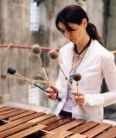  |
In 1986, Evelyn made her professional debut at London’s Wigmore Hall. Subsequent television broadcasts of her virtuoso performances led to wider recognition. [4] Many of these performances were firsts: the first time an orchestra played with a percussion soloist, the first solo percussion performance at a festival or venue, the first performance of a new percussion concerto. Her first CD, a recording of Bartok’s Sonata for two Pianos and Percussion with Sir George Solti, Murray Perahia and David Corkhill, won her a Grammy in 1988. In 1990, she published her autobiography, Good Vibrations (now out of print). That year Modern Drummer magazine readers voted her Best Classical Percussionist. In 1991, she was named the Royal Philharmonic Society’s “Soloist of the Year.” In 1993 she was awarded the OBE (Officer of the British Empire), extended in 2007 to “Dame Commander” for her services to music.
In 1994 she married composer, sound engineer and tuba player Greg Malcangi. They converted a barn on their property outside London into a rehearsal and recording studio. [4] They collaborated on several projects, composing award-winning music for British film and television. Evelyn also hosted Soundbites, a series of BBC-TV programs featuring interviews and performances with musical guests. [1] | 1986 events President: Ronald Reagan US space shuttle Challenger explodes, all 7 astronauts die, including school teacher Christa McAuliffe. Worst nuclear disaster in history at nuclear power plant in Chernoble, USSR, spreads radiation over large area. Iran-Contra scandal engulfs the Reagan administration. The US celebrates 1st national holiday honoring Martin Luther King, Jr. "A.M. Chicago" becomes the "Oprah Winfrey Show" and goes national. Marlee Matlin wins Best Actress Oscar for Children of Lesser God, the first deaf person to win an Oscar. |
Have Instruments, Will Travel
|
“Sometimes I wish I played the pennywhistle,” Evelyn says. [5] With more than 100 concerts a year worldwide, transporting her instruments, which can be difficult to clear through customs quickly, became a costly and logistical challenge. Many instruments are standardized, but there are variations in material, feel and size. Because she seeks tiny subtleties in performance, she prefers her own equipment and stores instruments on three continents to cut transportation and maintenance costs. [4] |   |
Her collection of more than 1000 percussion instruments includes the usual (marimba, xylophone, timpani, chimes, congas) and more exotic ones like steel pan, djembes, bodhrans, daiko drums and others of her own invention. Glennie’s Garbage, a line of cymbals she designed for the cymbal company Sabian, are welded from sheet metal. [1] However, when asked which instrument she would take with her if stranded on a deserted island, Evelyn said: “I think the snare drum would be my instrument. Yeah. I love the snare drum. Just me and my snare drum would be fine.” [3] At right: Evelyn and her snare drum | 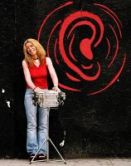  |
2000 -- present A new century brings new awards and challenges |
Symphony magazine has deemed Evelyn Glennie “... the individual most responsible for the emergence of percussion from the rear of the orchestra to front-and-center stage, both in fact and in public attention.” [1] When she began her career in 1986, solo literature for percussion was sparse, much of it unpublished. Since then she has commissioned 160 works for solo percussion from eminent composers like Thea Musgrave, Christopher Rouse, Steve Reich, and many others. She collaborates with them, choosing instrumentation that is practical for touring. | 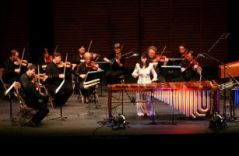  |
She insists on exclusive performance rights for one year, during which she performs it repeatedly. [2] In performance she plays barefoot to feel vibrations through the floor and in her body. [3] She supervises the sets and lighting, and performs in colorful, theatrical costumes.
A petite five-foot-two, she is a mesmerizing performer, moving with catlike grace between as few as 20 or as many as 50 instruments. [1] |
Critics praise her virtuosity and musicianship. | |
With New England Conservatory Wind Ensemble, Boston (1996): “She has technical command, whether playing with four mallets or six, timbral imagination and theatrical flair.” Her encore, Prim, by Islandic composer Askell Masson, “... was astounding for concentration, velocity, rhythmic clarity and impetus, and for the variety of sounds she could draw from two sticks and one drum. The end was heralded by an extended crescendo, which Glennie then surpassed by an equally extended, perfectly gauged diminuendo into silence.” [7] | |
Town Hall, New York City (2005): “A snare solo [Prim] might seem an unpromising prospect, but ... always an energetic and intensely focused performer, [Glennie] made the work’s rolls, rhythmic patterns and hard thwacks into something both musical and dramatic. [In Keiko Abe’s Memories of the Seashore] Glennie produced a gracefully undulating, dreamy sound. She drew on the [marimba’s] more extroverted character – to say nothing of her own virtuosity - in Toshimitsu Tanaka’s Two Movements and Leigh Howard Stevens’s Rhythmic Caprice. [8] | |
With the National Symphony, Carnegie Hall (2001): “Ms. Glennie is an engaging performer to watch. ... percussion playing is not just about making a great din. It can also mean whispering delicacy, swiftness, the unexpected, rhythms of lacy intricacy as well as ramming pulsation, and with Ms. Glennie at her best ... these things were there." [9] |   |
Although her performances continued to win raves that brought wider fame, fame has its downside. Her 2001 performance with the National Symphony (reviewed above) was led by American conductor Leonard Slatkin, then chief conductor of the BBC Symphony Orchestra. At right: Leonard Slatkin In 2003, Evelyn’s affair with the thrice-married Slatkin was widely publicized when her husband, Greg Malcangi, filed for divorce and published email exchanges between Evelyn and Slatkin. Their affair ended that summer, as did Evelyn’s marriage to Malcangi. [10] | 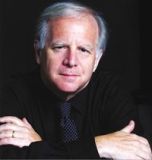  |
Evelyn's philosophy of music reveals much about her character. "The beauty of music is the communication between people. It doesn't matter what color they are, whether they are rich or poor, black or white, where they're from--it doesn't matter. The wonderful thing about percussion especially, is that there are no class barriers." [6] In addition to performing, recording and composing, she remains active with some 40 organizations for the deaf, including a program that provides music therapy for hearing-impaired children. |
She is an ardent advocate for music education. Her lobbying efforts, in conjunction with Sir James Gallway, Julian Lloyd Webber and the late Michael Kamen, led the British government to provide increased funding for music education. [1] She continues to compose music for television, film and corporations. After 20 years in the music business, she has begun teaching privately, which allows her to explore the art of teaching and to explore sound therapy as a means of communication. [5] |
A sampling of Evelyn Glennie’s awards and honors: Induction into the Percussion Arts Society Hall of Fame, 2008 Honored as Dame Commander of the British Empire, 2007 Sabian Lifetime Achievement Award, 2006 The film Touch the Sound: A Sound Journey with Evelyn Glennie, has won numerous awards: LOLA 2005 - German Film Prize for Best soundtrack and nomination for best Documentary. BAFTA 2004 - Scotland's award for best documentary film. Critic's Prize - Locarno International Film Festival. Golden Pigeon - Main prize of the International Documentary and Animation film Festival in Leipzig. Rhythm Magazine rated her Best studio percussionist and Best live percussionist for the years 1998, 2000, 2002, 2003, 2004 2003: Mark Hatfield Leadership Award for Outstanding Services to Deaf Children Musical America - Instrumentalist of the Year 2002 Grammy Award for Bela Fleck's Album 'Perpetual Motion' (Best Classical Crossover Album) 1998 DRUM Magazine, Percussionist of the Year Award 1997 Outstanding Individual Award, Alexander Graham Bell Association 1993 Classic CD Award for Veni, Veni, Emmanuel; Classical Music Awards Personality of the Year 1991 Royal Philharmonic Society's Charles Heidsieck Soloist of the Year Award Modern Drummer Magazine readers’ poll – Best Classical Percussionist 1988 Grammy Award - Bartok's Sonata for Two Pianos and Percussion |
COMMENTARY: Obstacles? What obstacles? Some might consider Evelyn's hearing loss an obstacle, but given her accomplishments, that might be difficult. She credits her no-nonsense parents for not making a fuss over her hearing loss. She prefers not to focus on her hearing disability. "I just happen to be a musician who happens to be deaf, who happens to play percussion, who happens to have brown hair, and so on!" [6]
She doesn't consider her gender an obstacle either, even if some people are surprised that such a petite woman can play such a huge battery of percussion instruments. "You don't need muscle," she says, "you just need to be supple. You need to be relaxed. Basic things need to be looked at like posture ... having the instruments at the suitable height for you is very important." [6] This may be true, but the number of female percussionists in classical orchestras is woefully low. A 2005 study shows that in 34 orchestras worldwide, women hold less than 3 percent of the positions in the percussion sections. This includes 7 U.S. orchestras, including the "Big Five" orchestras in New York, Boston, Philadelphia, Cleveland and Chicago. See Representation of Women in European and American Orchestras. Role models and Inspirations: Her teacher, composer-marimba player Keiko Abe, served as an early role model. She has also been inspired by cellist Jacqueline DuPre and pianist Glenn Gould. Her Legacy: In addition to leaving a vast audio, video and film legacy of outstanding musical performances, Evelyn Glennie serves as a role model for male and female percussionists and as an inspiration for the deaf and hearing impaired. |
Evelyn Glennie: A Partial Discography |
Rhythm Song, RCA Victor, 1990; Light in Darkness and Dancin’,1991 Rebounds: Concertos for Percussion, 1993; MacMillan: Veni, Veni, Emmanual, 1993; Wind in the Bamboo Grove, 1995; Drumming, 1996 Her Greatest Hits, and Reflected in Brass, 1998 Shadow Behind the Iron Sun, 2000; African Sunrise/Manhattan Rave, 2001 For a list of other recordings, visit her website: www.evelyn.co.uk Film and television appearances Touch the Sound: A Sound Journey with Evelyn Glennie, 2005 Soundbites (BBC), The David Letterman Show (USA), Sesame Street (USA), The South Bank Show (UK), This is Your Life (UK), 60 Minutes (USA), PBS Profile (USA) Watch Evelyn on YouTube! Evelyn plays Maple Leaf Rag |
SOURCES: 1. Evelyn Glennie Biography (2005), Brenda Sanchez 2. "Evelyn Glennie," Barbara Harbach, Women of Note Quarterly, Vol. 2-Issue 4, November 1994 3. "Beat of a Different Drummer," Jeffrey Brown (6-14-1999) 4. “The hushed world of percussionist Glennie,” Richard Dyer, Boston Globe (2-29-96) 5. Long biography, Evelyn Glennie website 6. “Percussionist Evelyn Glennie: A Conversation with Bruce Duffie, 1994 7. “Glennie’s triumph has no limits,” Richard Dyer, Boston Globe (3-1-96) 8. “A Snare Drum Solo? Why not? And Then Let’s Hear It for the Marimba,” NY Times, 2005 9. “From Delicate Whispers to a Furious Clamor,” Paul Griffiths, New York Times, 2004 10. "Love Bytes" By Lloyd Grove, Washington Post, July 10, 2003 |
© copyright 2009 Susan Fleet



